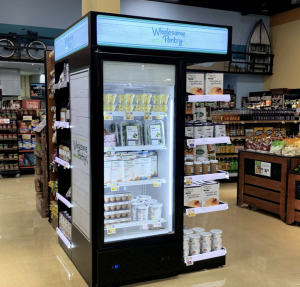
In the past year, the consumer shopping process has seen a change like no other. Economic factors coupled with the realities of how consumers shop, socialize and engage with brands during a global pandemic have compressed behavioral changes.
Technology innovations have significantly amplified the changes over the last 18 months. The net result is a newly emerging consumer mindset and muscle memory. This change drives expectation. The experience that a consumer receives determines where and how the consumer spends discretionary food dollars.
Some interesting data points illustrate this newly emerging reality:

Private Brands Growth Opportunities
According to the FMI’s 2020 Private Brands Report, COVID has markedly increased the demand for private brands in grocery.
The report compiled with sales data and shopper insights gleaned from industry data sources and survey responses found that 83% of food retailers expect to boost private brand strategies promoted as part of their e-commerce and digital service offerings. Further, 97% are rethinking assortment and supplier strategies to focus on bundled products supporting home cooking and meal preparation. Of the retailers surveyed by the FMI, 83% indicated their desire to focus on baked goods and deli as their areas for growth.
The Impact of Frozen on In-Store Traffic
While fresh foods can drive larger market baskets in e-commerce, where does this leave frozen products such as baked goods? Do frozen goods play a role in a retailer’s private label growth strategy given these items are not optimally suited for e-commerce? Can private label frozen items such as baked goods play a role in driving customer retention in-store and increase market basket values? Yes. However, it requires rethinking how frozen, fresh and packaged foods can be merchandised and positioned in the store to better take advantage what the new shopper is seeking.
The key is understanding that consumers are shifting and allocating part of their spend to e-commerce driven home delivery. However, a part of their spend will remain in-store, augmented with curbside and BOPIS. The store experience isn’t dead, it is simply evolving.
So, what does this survey data tell us? It implies that nearly half of consumers will never go back to shopping physical retail establishments in the same way they did three years ago. Thus, the physical shopping experience and how products are developed, merchandised and delivered to the consumer’s market basket needs to evolve to align with the newly emerging behaviors and expectations.
Merchandising’s New Model
Let’s focus on in-store. No food category is an island any longer. With the advent of more sophisticated and energy efficient specialty and end-cap coolers available for frozen products, cross promoting frozen products that have bundle value to certain consumers will drive improved market basket values.
Leveraging some of the new endcap and specialty frozen display technology which can occur in specialty departments and along the perimeter of the store, is an important strategy to attract shoppers, particularly younger consumers. Mixing frozen products in with fresh foods allows for effective promotional prompts to assist with meal and occasion planning as well as leverage greater discretionary spend opportunities.

Specialty endcaps can accommodate multiple categories of products from fresh to frozen and which are customized to remove friction for the consumer by providing curated product mixes. Leveraging these emerging strategies which include frozen foods into the curated product mix help to ensure sustained volumes of in-store traffic.
Terry Roberts, President of Merchandising by Design Inc., in his interview with Progressive Grocer, emphasizes that when cross-merchandising frozen packaged foods within specialty departments, seasonality is the most impactful way to deliver results. For example, if you have bushels of peaches, you can place a bushel next to ice cream, with recipes for peach cobbler a la mode.
That care extends to other aspects of physically co-merchandising fresh and frozen items, Roberts adds. “It requires planning and management,” she advises. “You need to sit down with a seasonal calendar, planning what comes in and out — and that includes meat and seafood — and how to do promotional activity accordingly.”
Other approaches lead to a greater linkage between the fresh and frozen. Burt Flickinger, Managing Director of New York-based Strategic Resource Group, points to work that Cornell University is doing in this area. Consumer behavior and competitive pressure are actively driving new product development in both fresh and frozen and retailers are innovating more aggressively in merchandising approaches in order to keep up with how the consumer’s mindset and behaviors are evolving. Flickinger points out, “We are seeing from analyses of Lidl in the U.K. that they are aggressively and progressively working in this area” “And … the talent that Amazon is hiring, along with Whole Foods, will make it a bigger player in that, too.”
Today, products and categories that five years ago would never have been co-mingled are considered viable merchandising strategies. Shoppers are looking for solutions to meal planning and snacking dilemmas. Providing the proper mix and merchandising makes it easy for consumers to act. The result is greater satisfaction, loyalty and basket values.
Consider a few simple in-store strategies to improve performance and outcomes. Specifically,

